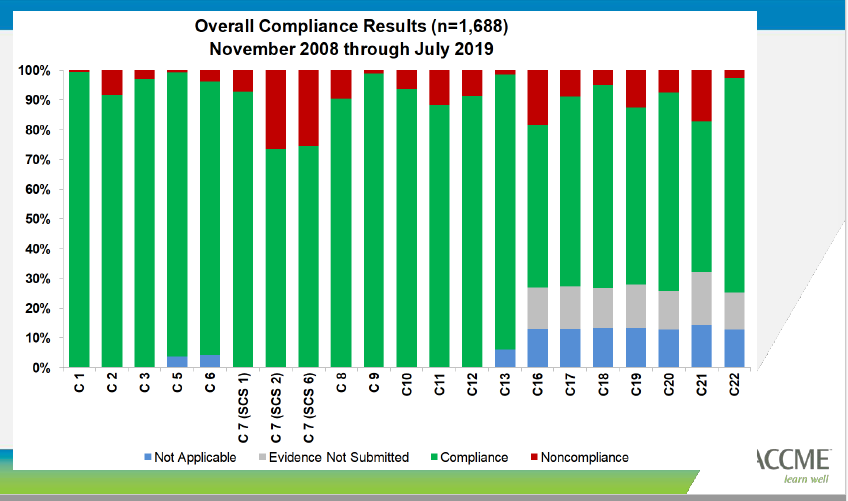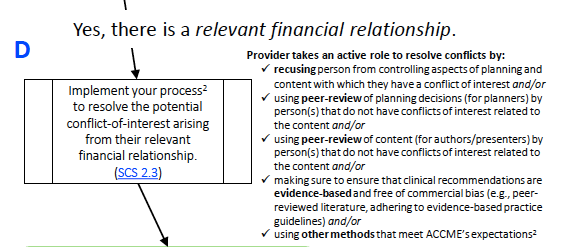Identification and resolution of conflict of interest (COI) remains one of the biggest areas of non-compliance in the process of re-accreditation—and an area of most confusion by accredited providers. The ACCME classifies these processes within Criterion 7 and the Standards of Commercial Support (SCS 2) of the accreditation requirements. According to a recent 2019 ACCME compliance summary report, approximately 30% of providers are still being found non-compliant for SCS 2 as excerpted below.

The C7 SCS 2 standard addresses three major processes that are considered so crucial in the re-accreditation process that falling short in any one of them can trigger a progress report.
- Identification of RELEVANT financial relationships for each person in control of content
- Resolution of PLANNER COI
- Resolution of PRESENTER/FACULTY COI
To assist accredited providers in achieving compliance, the ACCME developed a flow chart that can assist providers in a sequential process, from start to finish.
For purposes of this article, we will assume that you have screened disclosure information provided to you by planners, presenters/faculty and reviewers for relevant COI, and have eliminated any owners or employees of an ACCME-defined commercial interest from participating in the planning, development, delivery or evaluation of any activities related to their products and or services. al interests can have
no role in the planning or implementation of CME activities related to their products/services.
We are now at part D of flow-chart process, excerpted below:

The language “provider takes an active role to resolve conflicts” means that you cannot allow the person(s) with the relevant COI to resolve their own COI. They can help decide the resolution process and/or how it will be implemented, but the provider must maintain oversight of the process to ensure it is appropriate and implemented. If a person decides to immediately divest themselves of the relevant relationship, that action in itself is resolution of the conflict of interest, but the relevant relationship must still be disclosed to learners for the next 12 months.
For each COI you are resolving, be sure to document what processes were implemented, and who resolved the COI or ensured the resolution occurred. Typically, a resolution of COI form is completed for file documentation, but other forms of documentation may be used if they convey the appropriate oversight and review for bias that was implemented.
For planners with relevant COI, you must implement your planner resolution process at the start of the planning process. The term “planning decisions” includes selection of topics, content, objectives, agenda, faculty and evaluation content and methods.
The most common and easiest options are:
- Recusal: This means recusing (withdrawing due to impartiality) the conflicted planner from providing any input on planning decisions that are related to their relevant COI. They can be eliminated from the committee altogether, or recused from certain planning discussions if they relate to their COI. The non-conflicted planners need to be provided with the relevant COI information to ensure timely recusal, and be responsible to ensure it occurs when necessary.
OR
- Peer review of planning decisions: This means having a non-conflicted planner(s) be part of the planning process and approve the final planning decisions, ensuring any input from conflicted planners has been free of bias or commercial interest influence. The non-conflicted planner(s) must be a peer, meaning they have the appropriate expertise to determine the presence of bias as it may occur in the planning process. The non-conflicted peer planners must also be provided with the relevant COI information to ensure timely recusal and be responsible to ensure it occurs when necessary.
Be careful when it is a course or activity director who has a relevant COI. They are typically involved in many, if not all, of the planning decisions, and you may need their clinical expertise to maintain the integrity of the activity. Best practices show that engaging a non-conflicted co-director with enough expertise to be part of and approve (or amend as needed) all the planning decisions ensures the activity is free of bias.
For faculty, presenters and authors (or anyone developing activity content) with a relevant COI, you must implement your faculty/presenter resolution process before the content can be delivered to the learners.
The most common and easiest options are:
- Peer review of content: This means having a non-conflicted content reviewer review the content to determine the presence or absence of bias, and for balanced and evidence-based recommendations. The non-conflicted reviewer must be a peer, meaning they have the appropriate expertise to determine the presence of bias as it may occur in the content, and recommend amendments as needed.
- Only allowing evidence-based clinical recommendations: This means having a review of the clinical treatment recommendations referred to in the content, and only allowing those that are derived from appropriate peer-reviewed literature or current evidence-based practice guidelines and free of commercial bias. No opinions from the conflicted person can be expressed or delivered in the content.
For moderators or panelists with a relevant COI, you must implement your resolution process before the activity can be delivered to the learners. The terms “moderators” or “panelists” refer to those contributing to the activity content via panel discussions, commentary to other panelists or faculty/presenter comments or recommendations. This does not include moderators whose only role is time keeping or introductions, etc.
The most common and easiest option is:
- (For live activities) education and monitoring: This two-part process means 1) educating conflicted moderators or panelists about the requirement that any opinions or recommendations expressed need to be derived from appropriate peer-reviewed literature or current evidence-based practice guidelines and free of commercial bias and 2) having an assigned monitor in place for observation and any needed intervention, if bias is observed, and planning for what interventions would be appropriate. For example, the monitor could divert the discussion to another related topic while preparing a rebuttal to the audience if needed.
- (For enduring activities) peer review of content: Since enduring formats allow for written or recorded content to be reviewed prior to release, the above described “peer review of content” process can be implemented, provided edits can be made as needed before the activity is released.
For reviewers with a relevant COI, you must replace them. Reviewers cannot have a relevant COI.
Lastly, even though you have identified and resolved all relevant COI for every person in control of content, the final step in resolution of COI is to monitor participant perception of bias. This means having a way to gather learner feedback for any perceived bias in the content of the activity, and then following up on any concerning comments for future process improvements.